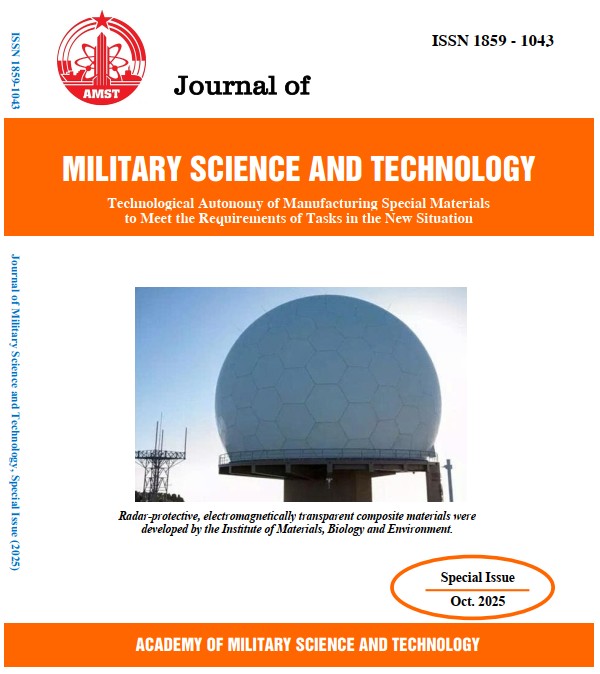Study on fabrication of nano copper by thermal plasma and their applications in thermal camouflage
DOI:
https://doi.org/10.54939/1859-1043.j.mst.IMBE.2025.63-69Keywords:
Thermal camouflage applications; Reduce thermal emission; Coating metal nanoparticles; Nanoparticle Cu.Abstract
In this study, we investigated the process of coating mica substrates with a layer of copper (Cu) metal nanoparticles to enhance thermal camouflage by reducing thermal emission. The Cu nanoparticles were fabricated using the Plasma Temperature method, achieving an average size of approximately 100 ÷ 200 nm. The structure, morphology, composition, and properties of Cu nanoparticles were characterized by scanning electron microscopy (SEM), energy-dispersive X-ray spectroscopy (EDX), and Fourier transform infrared (FTIR). The infrared emission characteristics after coating Cu metal nanoparticles on mica substrates were measured by an SR5000N spectrophotometer, an SR800N-7° absolute blackbody, and a Flir Armasight thermal imaging camera. The results indicated that the material samples containing 10% Cu and 50% Cu had noticeably lower emission intensities compared with the other samples, especially in the long-wavelength region. This was applied to the Cu nano-coating work, which reduced the thermal emission of mica. This result demonstrated the ability of the nano-metallic material to modulate the surface emission rate, thereby reducing the detectability of the object by thermal imaging devices for camouflage applications.
References
[1]. J. Chao et al., “Optical properties and applications of metal nanomaterials in ultrafast photonics: a review,” J. of Materials Science, Vol. 59, pp. 13433-13461, (2024).
[2]. P. C. Hsieh et al., “Epsilon-near-zero thin films in a dual-functional system for thermal infrared camouflage and thermal management within the atmospheric window,” Materials Horizons, Vol. 11, pp. 5578-5588, (2024).
[3]. I. Khurshid et al., “Metallic Nanoparticles for Imaging and Therapy,” Functional Smart Nanomaterials and Their Theranostics Approaches. Singapore: Springer Nature Singapore, pp. 65-86, (2024).
[4]. S. Yu et al., “Noble Metal Nanoparticle-Based Photothermal Therapy: Development and Application in Effective Cancer Therapy,” Int. J. Mol. Sci., Vol. 25, pp. 5632 (1-25), (2024).
[5]. Q. Peng et al., “Recent advances in transition-metal based nanomaterials for noninvasive oncology thermal ablation and imaging diagnosis,” Front. Chem., Vol. 10, pp. 899321 (1-12), (2022).
[6]. L. Sansone et al., “Recent Advances in Graphene Adaptive Thermal Camouflage Devices Nanomaterials, Vol. 14, pp. 1394 (1-23), (2024).
[7]. B. Yan et al., “Flat-Shaped Copper Nanoclusters with Near-Infrared Absorption for Enhanced Photothermal Conversion,” JACS Au, Vol. 5, pp. 1884-1893, (2025).
[8]. S. Boscarino et al., “Morphology, Electrical and Optical Properties of Cu Nanostructures Embedded in AZO: A Comparison between Dry and Wet Methods,” Micromachines, Vol. 13, pp. 247 (1-16), (2022).
[9]. P. Bazarnik et al., “Enhanced thermal stability of nanocrystalline Cu composites processed by high-pressure torsion: The pinning effect of Al₂O₃, GO, and rGO/Al₂O₃ nanoparticles,” J. of Alloys and Compounds, Vol. 1033, pp. 181283 (1-12), (2025).
[10]. X. D. Zhang et al., “Thermal evolution and optical properties of Cu nanoparticles in SiO2 by ion implantation,” Optical Materials, Vol. 33, pp. 570-575, (2011).







